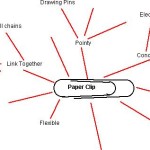Seeing What Others Miss
 To find opportunities that others fail to see, or solve problems that others cannot solve, you must look at them differently than others do. The brain works associatively as well as linearly – comparing, integrating and synthesizing as it goes. By employing a process Fidía calls Opportunity Mapping™, you can overcome the built-in bias to approach problems linearly.
To find opportunities that others fail to see, or solve problems that others cannot solve, you must look at them differently than others do. The brain works associatively as well as linearly – comparing, integrating and synthesizing as it goes. By employing a process Fidía calls Opportunity Mapping™, you can overcome the built-in bias to approach problems linearly.
Humans are so comfortable with linear progression that we hardly are aware of how it influences us, positively and negatively. It’s no wonder we do things in a linear fashion without thinking about it: we read from right to left in a line; we think of our day as a march from morning to evening to morning in sequence; we look for the shortest distance between to points. Our culture predisposes us to see the world as a linear progression.
Map a New View
Opportunity Mapping™ is based on a process called mind mapping. For convenience, we will use the two terms interchangeably here. An Englishman by the name of Tony Buzan is credited with developing mind maps, and there are books and web sites devoted to the process. While Fidía’s Opportunity Mapping™ utilizes classic mind mapping extensively it also includes additional processes and selection criteria to help separate true opportunities from merely neat ideas.
Association plays a dominant role in nearly every mental function, and words themselves are no exception. Every word and idea has numerous links attaching it to other words, ideas and concepts. A mind map results from actually plotting out these thoughts and links in a way that illuminates associations (connections) that had not been visible or obvious before. In other words, Opportunity Mapping™ generates new ideas by connecting the dots between two or more facts, ideas or concepts in ways that may have been missed previously.
How to Create a Mind Map
To begin creating a mind map, place the central word, phase or question in the center of the page and draw a circle around it. This is the HUB. Now draw a spoke outward in any direction. At the end of the spoke write the word or phrase that you associate with the HUB. Draw a circle around this word or phrase. This circle can now be thought of as a HUB and you can now associate another thought with this new HUB. You may hang as many spokes as you like from any HUB. You will quickly produce a growing structure of related, linked key words, issues and images.
As you continue the process you may recognize relationships, associations and similarities between any two or more unlinked HUBS, and connect the dots to the extent useful. Because of the large amount of association involved, the mind mapping process can be very creative, generating new ideas and associations that have not been thought of before.
In my next post about Opportunity Mapping, I will include sample graphics or a downloadable document (if I can figure out how to do that) that will illustrate how to use this powerful technique.


